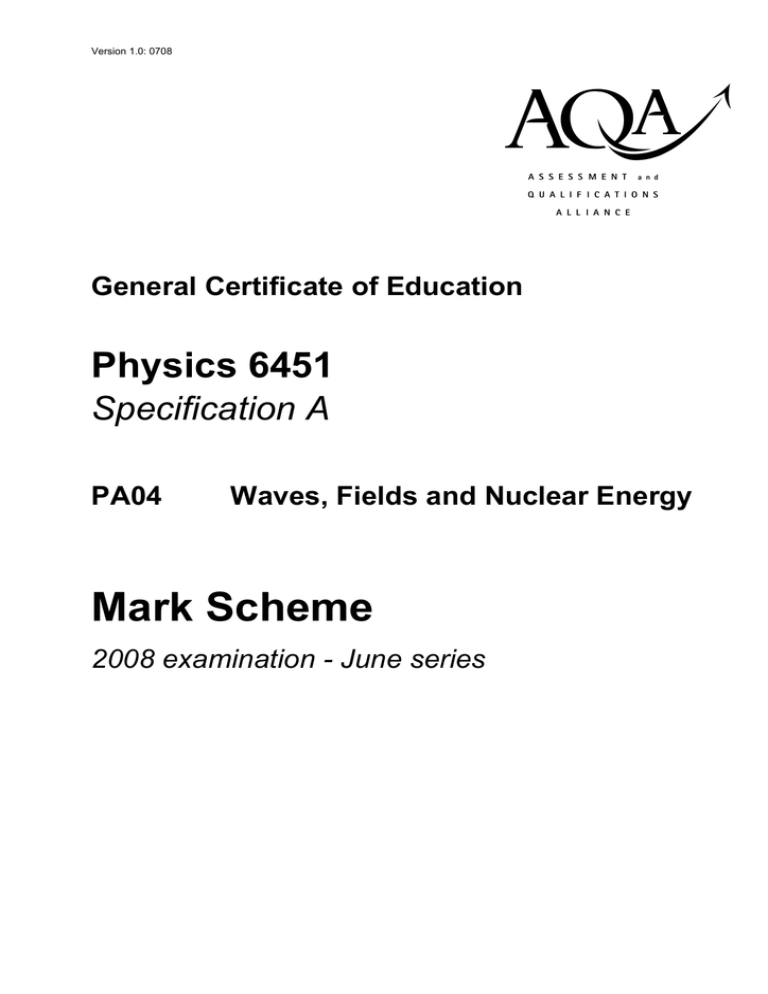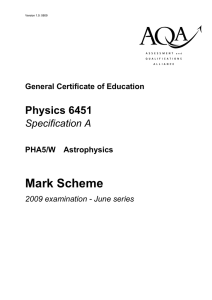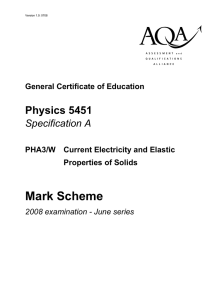
Version 1.0: 0708
abc
General Certificate of Education
Physics 6451
Specification A
PA04
Waves, Fields and Nuclear Energy
Mark Scheme
2008 examination - June series
Mark schemes are prepared by the Principal Examiner and considered, together with the
relevant questions, by a panel of subject teachers. This mark scheme includes any
amendments made at the standardisation meeting attended by all examiners and is the scheme
which was used by them in this examination. The standardisation meeting ensures that the
mark scheme covers the candidates’ responses to questions and that every examiner
understands and applies it in the same correct way. As preparation for the standardisation
meeting each examiner analyses a number of candidates’ scripts: alternative answers not
already covered by the mark scheme are discussed at the meeting and legislated for. If, after
this meeting, examiners encounter unusual answers which have not been discussed at the
meeting they are required to refer these to the Principal Examiner.
It must be stressed that a mark scheme is a working document, in many cases further
developed and expanded on the basis of candidates’ reactions to a particular paper.
Assumptions about future mark schemes on the basis of one year’s document should be
avoided; whilst the guiding principles of assessment remain constant, details will change,
depending on the content of a particular examination paper.
Further copies of this Mark Scheme are available to download from the AQA Website: www.aqa.org.uk
Copyright © 2008 AQA and its licensors. All rights reserved.
COPYRIGHT
AQA retains the copyright on all its publications. However, registered centres for AQA are permitted to copy material
from this booklet for their own internal use, with the following important exception: AQA cannot give permission to
centres to photocopy any material that is acknowledged to a third party even for internal use within the centre.
Set and published by the Assessment and Qualifications Alliance.
The Assessment and Qualifications Alliance (AQA) is a company limited by guarantee registered in England and Wales (company number 3644723) and a registered charity (registered charity number 1073334).
Registered address: AQA, Devas Street, Manchester M15 6EX
Dr Michael Cresswell Director General
Physics A PA04 - AQA GCE Mark Scheme 2008 June series
Instructions to Examiners
1
Give due credit to alternative treatments which are correct. Give marks for what is
correct; do not deduct marks because the attempt falls short of some ideal answer.
Where marks are to be deducted for particular errors specific instructions are given in
the marking scheme.
2
Do not deduct marks for poor written communication. Refer the script to the Awards
meeting if poor presentation forbids a proper assessment. In each paper candidates
may be awarded up to two marks for the Quality of Written Communication in cases of
required explanation or description. Use the following criteria to award marks:
2 marks:
Candidates write legibly with accurate spelling, grammar and punctuation;
the answer containing information that bears some relevance to the
question and being organised clearly and coherently. The vocabulary
should be appropriate to the topic being examined.
1 mark:
Candidates write with reasonably accurate spelling, grammar and
punctuation; the answer containing some information that bears some
relevance to the question and being reasonably well organised. Some of
the vocabulary should be appropriate to the topic being examined.
0 marks:
Candidates who fail to reach the threshold for the award of one mark.
3
An arithmetical error in an answer should be marked AE thus causing the candidate to
lose one mark. The candidate’s incorrect value should be carried through all
subsequent calculations for the question and, if there are no subsequent errors, the
candidate can score all remaining marks (indicated by ticks). These subsequent ticks
should be marked CE (consequential error).
4
With regard to incorrect use of significant figures, normally two, three or four
significant figures will be acceptable. Exceptions to this rule occur if the data in the
question is given to, for example, five significant figures as in values of wavelength or
frequency in questions dealing with the Doppler effect, or in atomic data. In these cases
up to two further significant figures will be acceptable. The maximum penalty for an
error in significant figures is one mark per paper. When the penalty is imposed,
indicate the error in the script by SF and, in addition, write SF opposite the mark for that
question on the front cover of the paper to obviate imposing the penalty more than once
per paper.
5
No penalties should be imposed for incorrect or omitted units at intermediate stages in a
calculation or which are contained in brackets in the marking scheme. Penalties for unit
errors (incorrect or omitted units) are imposed only at the stage when the final answer to
a calculation is considered. The maximum penalty is one mark per question.
6
All other procedures, including the entering of marks, transferring marks to the front
cover and referrals of scripts (other than those mentioned above) will be clarified at the
standardising meeting of examiners.
3
Physics A PA04 - AQA GCE Mark Scheme 2008 June series
GCE Physics, Specification A, PA04, Waves, Fields and Nuclear Energy
Section A
This component is an objective test for which the following list indicates the correct answers
used in marking the candidates’ responses.
Keys to Objective Test Questions
1
C
2
A
3
A
4
D
5
B
6
A
7
C
8
D
9
D
10 11 12 13 14 15
C A B D C B
Section B
Question 1
(a)
⎛
m ⎞⎟
1
T ⎜ = 2π
gives
= 2π
⎜
⎟
0
.
92
k
⎝
⎠
400
!
k
2
from which k = 1.3(4) × 104 N m-1 !
[or by use of effective spring constant for all four springs:
springs in parallel so k’ = 4k for a total mass of 1600 kg]
(b)
(i)
when t = 0.20 s
x(= A cos 2π ft) = 90 cos 2π (0.92 × 0.20) !
gives x = 36(.3) mm !
downwards !
(ii)
vertical speed v (= 2π f
A2 − x 2 )
= 2π × 0.92
((90 × 10 −3 ) 2 − (36.3 × 10 −3 ) 2 )
max 4
!
[or v = (-2π fA sin 2πft)
= (-) 2π × 0.92 × 90 × 10-3 sin (2π × 0.92 × 0.20) !]
gives v = 0.47(6) m s-1 !
(c)
same period maintained throughout graph !
2
exponential decay of amplitude !
(d)
(i)
resonance !
(ii)
3300 (rev min-1) !
2
Total
4
10
Physics A PA04 - AQA GCE Mark Scheme 2008 June series
Question 2
(a)
(i)
bright and dark bands (or fringes) !
equally spaced !
of similar intensity to each other (or suitable comment about
decrease of intensity outwards from centre) !
(ii)
max 4
central band wider than others !
intensity decreases greatly away from centre of pattern !
(b)
(i)
(ii)
fringe width w =
λ=
58
= 2.9 mm !
20
ws
w w′
gives
(since λ and s are constant) !
=
D
D D′
5
2 .9
3 .7
gives D = 2.9 m !
=
D D + 0.80
(iii)
λ=
2.9 × 10 −3 × 0.60 × 10 −3
! = 6.0 × 10-7 m (600 nm) !
2.9
Total
5
9
Physics A PA04 - AQA GCE Mark Scheme 2008 June series
Question 3
(a)
(i)
gravitational force (or field) decreases as r increases !
gravitational force (or field strength) is proportional to (1/r2) !
[award both marks for second statement alone]
(ii)
4
⎛ Fr 2 ⎞ 1600 × (1.75 × 10 6 ) 2
mass of Moon M ⎜ =
!
⎟=
⎝ Gm ⎠ 6.67 × 10 −11 × 1000
= 7.3(5) × 1022 kg !
[or by use of any other consistent values of F and r]
(b)
(i)
EP lost = area under graph !
acceptable method for finding area and values !
acceptable value for EP lost ! [allow (2.8 ± 1.0) × 109 J]
[alternative mark scheme, for candidates who use values
from the graph:
potential of Moon’s surface
6.67 × 10−11 × 7.35 × 10 22
⎛ GM ⎞
=⎜−
= – 2.80 × 106 (J kg-1) !
⎟=−
r ⎠
1.75 × 106
⎝
change in potential ΔV = (– 2.80 × 106) – 0
= (–) 2.80 × 106 (J kg-1) !
potential energy lost (= m ΔV) = 1000 × 2.80 × 106
5
= 2.80 × 109 J !]
(ii)
½ mv2 = 2.8 × 109 (or the EP value from (b) (i)) !
gives escape speed v = 2370 m s-1 (or a consistent value) !
[alternative mark scheme, for candidates who use
gravitational potential equation:
½ mv2 =
GMm
gives v =
r
=
2GM
r
2 × 6.67 × 10 −11 × 7.35 × 10 22
!
1.75 × 10 6
= 2370 m s-1 !]
Total
6
9
Physics A PA04 - AQA GCE Mark Scheme 2008 June series
Question 4
(a)
(b)
1.4 × 10 −3 × 9.81
⎛ F⎞
! = 7.6(3) A !
current I ⎜ = ⎟ =
⎝ Bl ⎠ 45 × 10 −3 × 40 × 10 −3
(i)
2
magnetic flux change Φ (= BA)
= 45 × 10-3 × 40 × 10-3 × 20 × 10-3 !
= 3.6 × 10-5 Wb !
(ii)
use of ∈ =
ΔΦ
3.6 × 10 −5
! gives time taken Δt =
!
Δt
0.15 × 10 −3
5
= 0.24 s !
[alternative for (ii)
0.15 × 10 −3
⎛ ∈⎞
v⎜= ⎟ =
! = 8.33 × 10-2 (m s-1) !
−
3
−
3
⎝ Bl ⎠ 45 × 10 × 40 × 10
Δt =
l
20 × 10 −3
= 0.24 s !]
=
v 8.33 × 10 − 2
Total
7
Question 5
(a)
(i)
fission reaction is induced by neutron bombardment (or neutron
absorption) !
fission releases neutrons !
max 4
released neutrons cause more fissions !
(ii)
minimum mass of fissile material !
for self-sustaining reaction to be maintained !
(b)
(i)
carbon (graphite) or water !
effective in slowing neutrons (or has relatively low mass
atoms/molecules) !
does not absorb neutrons !
(ii)
max 4
carbon dioxide (gas) or water !
high (specific) heat capacity [or absorbs heat well] !
flows readily !
Total
Quality of Written Communication Q2 (a) and/or Q5 (a)
7
8
2




